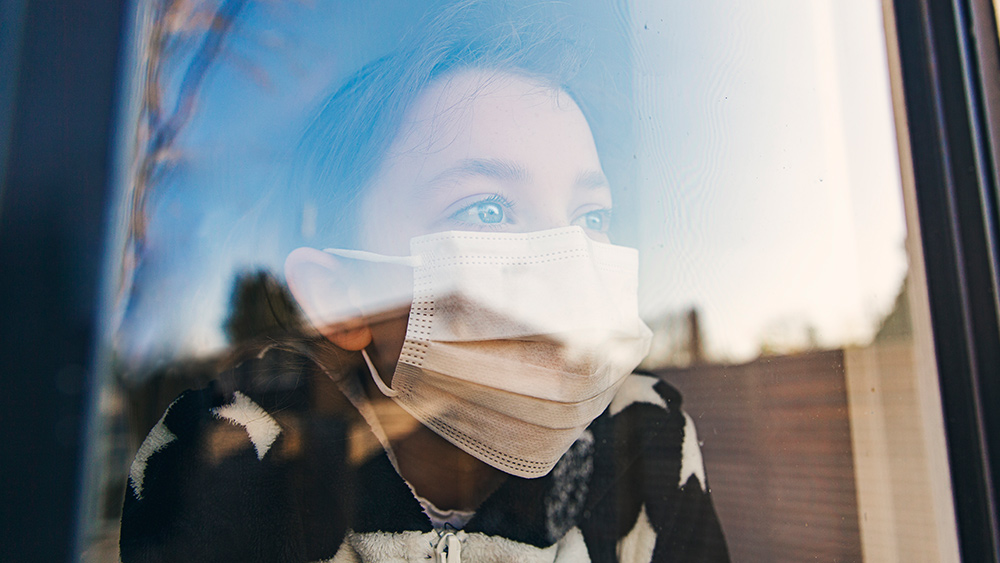FINDING: Masks will silently deprive humans of oxygen for years to come through microplastic pollution
03/25/2022 / By Lance D Johnson

For the first time, scientists have detected microplastic pollution in human blood. The study, published in Environment International, detected plastic particles in almost 80% of the people they tested. These microplastics may be consumed or inhaled. These microplastics can attach to red blood cells, harming oxygen utilization in the bloodstream. They also interfere with glandular function, causing hormonal changes in the human body.
The study found that the microplastics not only get into the body but they also travel throughout the bloodstream and lodge in human organs. In laboratory studies, microplastics damage human cells, disrupt hormones and contribute to premature death. Plastic bottles, styrene food and beverage containers, and plastic shopping bags all contribute to this ever-present health threat, and that’s not all.
Masks will cause long term damage to oxygen utilization in humans
Today, people willingly breathe in these microplastics by attaching masks to their faces. And, as the face masks are discarded en masse, the microplastics break down into the air, soil, and water, before finding their way into human blood and organs. Masks strain, suffocate, and poison people in an acute manner, and over the long haul, the microplastics break down in the environment, silently infiltrating the blood, and depriving red blood cells of oxygen. In one study, microplastics latched onto the outer membrane of red blood cells, hindering their ability to transport oxygen throughout.
At the height of the mask mandate hysteria, the world population was consuming 129 billion disposable face masks each month, or approximately three million masks every minute. Many of these masks are discarded into the environment or dumped in landfills, where they will break down and pollute the soil for years.
Disposable face masks contain an inner layer of thermoplastic polymers that are melted together into porous sheets. When they break down in the environment, these polymers and polypropylene fabrics break down into small plastic particles called microplastics. These microplastics leech into the soil and water, and ultimately make their way into human blood, tissues, and organs. These particles also travel through the air and are often taken in through the lungs. The long-term environmental and human health effects caused by mask mandates are yet to be fully realized. These negative impacts will be measured in human blood in the form of microplastic contamination.
Plastic pollution, exacerbated by masks, affects human hormones, childhood development
In the Environment International study, half the blood samples contained PET plastic, the kind that comes from plastic soda bottles. One third of the blood samples contained polystyrene, the hormone disrupting chemical used to manufacture Styrofoam containers. One quarter of the blood samples contained polyethylene, which is commonly used in grocery bags. Lead researcher, Professor Dick Vethaak from the Vrije Universiteit Amsterdam, said this is the “first indication that we have polymer particles in our blood.” He says further studies are needed to assess the presence of many more plastic polymers and understand what these microplastics are doing to the human body.
“The particles are there and are transported throughout the body,” he said, so it is “certainly reasonable to be concerned.” In his previous work, Vethaak found microplastic contamination to be ten times higher in babies because they are fed with plastic bottles. Babies are especially vulnerable to the negative effects; studies show the particles travel through the lungs and into the heart and brain, affecting neurodevelopment. More health studies should be conducted on people who regularly wear face masks. How might inhalation of microplastics affect one’s ability to transport oxygen in their blood over time? How might this exposure affect one’s hormones and cancer risk?
The amount and type of microplastics detected in the study varied considerably, as this was the first study to detect microplastics as small as 0.0007mm. Vethaak said the differences in microplastic levels might reflect short-term plastic exposures that occurred before the blood samples were taken, such as drinking from a Styrofoam cup or wearing a disposable face mask.
“The big question is what is happening in our body?” Vethaak said. “Are the particles retained in the body? Are they transported to certain organs, such as getting past the blood-brain barrier?” And are these levels sufficiently high to trigger disease? We urgently need to fund further research so we can find out.”
This video is from the Health Ranger Report on Brighteon.com.
Sources include:
Submit a correction >>
Tagged Under:
This article may contain statements that reflect the opinion of the author
RECENT NEWS & ARTICLES
BadMedicine.News is a fact-based public education website published by BadMedicine News Features, LLC.
All content copyright © 2019 by BadMedicine News Features, LLC.
Contact Us with Tips or Corrections
All trademarks, registered trademarks and servicemarks mentioned on this site are the property of their respective owners.




















